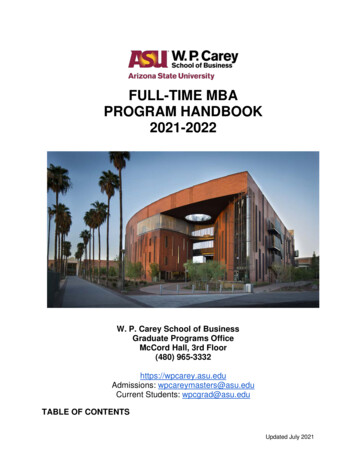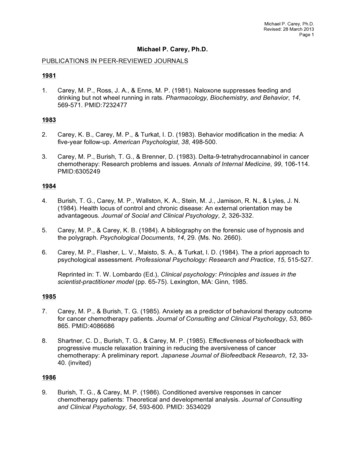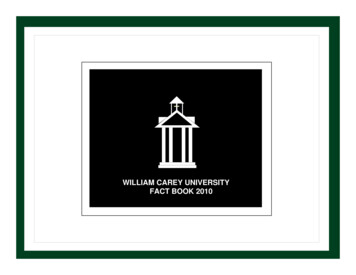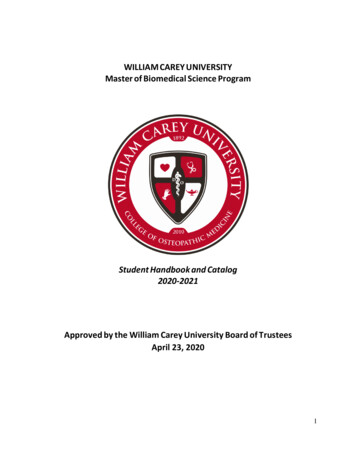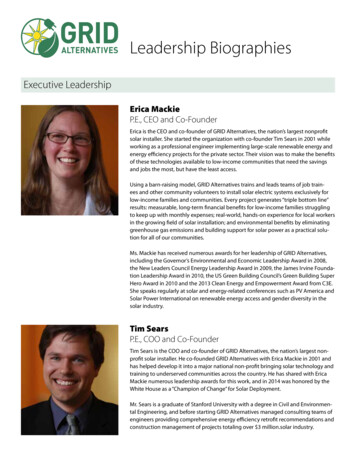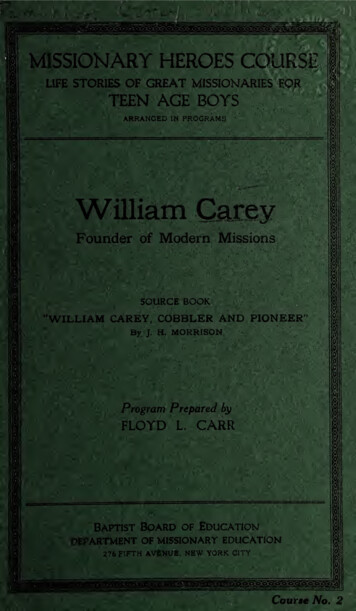
Transcription
\H PROGRAMSm?7 TT.«»!Mp?MORRISONSlSlSliL. CARRKMBof EducationONART EDUCATIONNEW YORK CITYfe? ' ' ‘ '.yY«V, *?: i/?:! .';.Course Afo. 2
&# i-vWMsbg& - .,; . ?.-, - .*. ;. * *;y”'x -'%v iK*i-W--'''*-,iifs5.''r*s«'" %. - . ’ ' *-r’,*. s g&, ;/ - r'-.iZ::. i.,; -; - ' '- - ' . : v-.A; . 5« . .' ?.? * .«. .- . r. - .fc% 0p&:3 -'
William CareyFounder of Modern MissionsSOURCEBOOK“William Carey, Cobbler and Pioneer”By J. H. MorrisonBaptist Board of EducationDEPARTMENT OF MISSIONARY EDUCATION276 Fifth Avenue, New York City
OUTLINEPageIntroductory Statement .2Program for Meeting .3LifeSketch.a.4LifeIncidents .7Program based uponWilliam Carey, Cobbler and Pioneerby J. H.MorrisonHodder and Stoughton, Limited, 1.50TFOREWORDHE Missionary Heroes Course for Boys meets a real need.It is a series of missionary programs for boys based on greatbiographies which every boy should know.Courses NumberOne and Number Two are now available, each providing pro grams for twelve months, which may be used in the monthlymeetings of boys’ groups. Other courses are in preparation andwill be issued for subsequent years.It is suggested that the leader purchase two copies of eachbooklet; one to be kept for reference and the other to be cut upto provide each boy with his assigned part. Some may preferto purchase one booklet and typewrite the parts for assignment.In order to tie together the life incidents as they are presentedby the boys, the leader should master the facts outlined in thebiographical sketch and read carefully the volume upon whichthe program is based. These volumes are missionary classicsand may be made the basis of a worthwhile library of Christianadventure.Boys are keenly interested in stories of adventure and achieve ment and it is hoped that participation in the programs will leadmany of the lads to read these great missionary biographies. At tention is called to the twenty-three other life-story programs nowavailable for Courses Number One and Number Two, both ofwhich are listed on the last page. The books upon which theseprograms are based can be ordered from the nearest literatureheadquarters. Portraits of these missionary heroes are also avail able for purchase at fifteen cents a copy.While these programs have been developed to meet the needsof boys’ organizations of all types—i.e., Organized Classes, BoyScouts, Knights of King Arthur, Kappa Sigma Pi, etc.,—theywere especially prepared for the chapters of the Royal Ambas sadors, a missionary organization for teen age boys originatingin the Southland and recently adapted to the needs of the North ern Baptist Convention by the Department of Missionary Edu cation. We commend these materials to all lovers of boys.William A. Hill.
PROGRAM FOR MEETING1.Scripture Reading: Acts 2:1-12. Verse 11: 'AVe do hearthem speak in our tongues the wonderful works of God,”appears on the pictured page of manuscript before WilliamCarey in the portrait bv Robert Home. This passage has beencopied in part from Carey’s Sanskrit New Testament. San skrit was the "mother tongue” of most of the languages inIndia and upon this foundation Carey and his helpers trans lated the Bible in full into five other tongues and in partinto twenty-eight branches. (See "William Carey,” by J. H.Morrison, pages 163-164 and the excerpt No. 12, following.)2.Prayer.3. Hymn: "Jesus, and Shall It Ever Be?” This hymn wassung at the baptism of Krishna Pal, the first native to bebaptized, after seven long years of labor. It has a challengeto courageous Christian manhood for our own age.(Seepages 113-114 of above book and excerpt No. 10, following.)4.Introduction to the Life Story1* (based upon the brief sketchin this booklet.)5. His Birth and Early Interests (pages 6, 7-9, 10 of the abovebook.)6.His Conversion and Baptism (pages 15-16, 18-19, 28.)7.Carey Urges the Cause of Missions (pages 39, 44-45, 53.)8.Dark Days in India (pages 64-66, 70-72, 90-91.)9.Removal to Serampore (pages 99-100, 102, 105-106.)10.Carey Baptizes His First Convert (pages 113-115, 116-117.)11. Carey is Appointed to a Professorship (pages 124-125, 216217.)12.Progress in Translating the Scriptures (pages 81-83, 111112, 120-121, 123, 191.)13.The Disastrous Fire (pages 160, 161-163.)14. The Abolition of Sati (widow burning)151-153.)(pages 156-157,15.The Founding of Serampore College (pages 179-180.)16.The Passing of William Carey (pages 212, 213, 215, 216,217-218.)* The leader should master the brief summary given in this booklet, and read thebrief life of William Carey by J. H. Morrison, upon which the program is based. Forthose who have the leisure, the reading of “William Carey” by S. Pearce Carey isrecommended.3
SKETCH OF THE LIFE OFWILLIAM CAREYWILLIAM CAREY, the Founder of Modern Missions, wasborn at Paulers Pury, Northamptonshire, England, onAugust 17, 1761. Six years after his birth, his father, EdmundCarey, became the village schoolmaster and the parish clerk, andthe lad was given an excellent elementary schooling. Upon leav ing school at the age of twelve, he attempted gardening for a timebut at fourteen was apprenticed to a shoemaker. During his ap prenticeship he came into contact with John Warr, a fellowapprentice, who won him to Christ and to fellowship with NonConformists. On October 5, 1783, he was immersed into the mem bership of the Northamptonshire Baptist Church by its Pastor,John Ryland.Two years before his baptism, he had married DorothyPlackett. Shortly after his marriage, he began to serve as a laypreacher and gave earnest study to Latin, Greek and Hebrew. In1785 he was called to the Pastorate of the Moulton Church,supplementing his stipend by cobbling shoes. Four years laterhe was called to the Harvey Lane Church, Leicester. Thoughfaithful to his parish duties, his heart was stirred by the needsof the non-Christian world. He read the reports of the East IndiaCompany, the 44Voyages of Captain Cook” and the lives of JohnEliot and David Brainerd. He said frankly to his critics, “Mybusiness is to extend the kingdom of God; I only cobble shoesto pay expenses. ’7On May 31, 1792—three centuries after Columbus made hisepoch-making announcement—William Carey preached his his toric sermon before the Nottingham Association upon the textIsaiah 54 :2-3, ‘ ‘ Enlarge the place of thy tent-, 7 7 challenginghis hearers with this “burning bush of missionary revelation.”He packed his sermon into a memorable watchword: “Expectgreat things from God. Attempt great things for God.” Fourmonths later, on October 2, 1792, representatives of the North ampton Association met at Kettering and formed the first modernforeign mission society. Their pledged resources totaled 13,2s. 6d. (about 65.00). The next January William Carey vol unteered for India and, with John Thomas, was formallyappointed as their missionary.Five months later Carey and his family were on their way toIndia, arriving at Calcutta November 11, 1793. Their resources,however, proved inadequate and for months Carey knew realwant. He finally moved to Debhatta to till some rent-free land.4
but through John Thomas he eventually secured a position asoverseer of a jute factory at Mudnabati. Six busy years followed,filled with executive duties, preaching services and translationlabors, before he was rejoiced with tidings of the coming ofreinforcements. Upon the arrival of Joshua Marshman andWilliam Ward, he decided to join them in founding a missionstation at Serampore (under the protection of the Danish govern ment). Carey arrived at Serampore on January 18, 1800, join ing Ward and Marshman in a communistic fellowship based uponthe Moravian plan, forming an “agreement” that was to lastthrough an eventful generation.Near the close of the first year at Serampore, but not untilafter seven years of faithful witnessing in India, Carey had theunspeakable joy of baptizing Krishna Pal, the first fruits of amighty harvest in India. Krishna Pal eventually became anordained preacher, who labored faithfully in the Gospel ministryfor twenty-two years. The next year marked still another tri umph, for, on March 5, 1801, a bound copy of the Bengali NewTestament was laid upon the Communion Table in solemn dedica tion. A month later, William Carey, termed in ridicule “TheConsecrated Cobbler,” was invited to become the Professor ofLanguages at Fort William College, Calcutta. He dedicated hisliberal salary to the needs of the mission and enlisted his helpersand pupils in extending his work of translation. On June 26,1809, he completed the first revision of his Bengali Bible. Henext turned to the Sanskrit, as the mother tongue of India, andtoiled for fourteen years, until finally, in 1819, the Sanskrit Biblewas completed. Even the disastrous fire which in 1812 destroyedtheir printing plant and many valuable manuscripts, did notmaterially check his amazing progress.The early hardships and bereavements of the first few yearsin India had unsettled the mind of Carey's wife and in 1807 shepassed away. The following year he married Charlotte E. deRumohr, a Danish lady, who was in warmest sympathy with hislabors and plans. She had been immersed into the membershipof the Serampore Church and actively cooperated in the work.The next advance of the mission was the opening in 1819 ofSerampore College, founded upon a broad foundation, for thestudy of India’s cultural riches and of European sciences. The 15,000 required for the eight acres of land and the statelybuildings were provided from the earnings of the mission. Theylooked to England for its maintenance and their faith was notdisappointed. The comprehensive scope of their program revealsthe outstanding ability of William Carey and his associates.5
Shortly after the founding of the college, Carey was againbereaved by the death of his devoted wife, Charlotte. For thir teen years, in spite of delicate health, she had been his unfailinginspiration. Two years later, he married Mrs. Grace Hughes, whowas his faithful companion during the sunset years of his life.Two outstanding events heightened the glory of those sunsetyears. The first was the privilege of translating, as the Govern ment ’s Bengali translator, the edict abolishing Sati (widowburning). Carey, who had led the crusade in India against thishorrible custom, gave his pulpit to another that Sunday morning(December 6, 1829) in order to lose no time in proclaiming theepoch-making edict. The second event was the completion inJune, 1832, of his final revision of the Bengali Bible. He tookthe first bound copy into the pulpit and quoted Simeon’s swan song in expression of his joy: “Now lettest thou thy servantdepart in peace”—(Luke 2:29-32). Two years later on June 9,1834, the Father of Modern Missions passed beyond the sunset toeternal day.%6
INCIDENTS IN THE LIFE OFWILLIAM CAREYReprinted from “William Carey/’by J. II. Morrisonby permission of the publishers, Holder and Stoughton, LimitedHis Birth and Early Interests.(Pp. 6, 7-9, 10.)William Carey was born on the 17th of August 1761, in thevillage of PaulersPury in Northamptonshire. His father, EdmundCarey, wTas the son of the village school-master, but, being left anorphan when only seven years old, he had been apprenticed to aweaver. Edmund appears to have been a studious lad, and waswarmly devoted to his mother, who was very delicate. When hemarried he took her to live with him, and she was spared to seethe birth of two grandchildren, William and his sister Ann . . . .The school was next door to the house and had a bit of play ground in front, shaded by two spreading plane trees. Behindwas a large garden with fruit trees. To William it was an un failing delight. His uncle Peter was a gardener and the boy wasan apt pupil. Under his care the schoolhouse garden came tobe the best kept in the village. This early passion for gardeningremained with him throughout life. As has been truly said ofhim, “Wherever he lived, as boy or man, poor or in comfort,William Carey made and perfected his garden, and always forothers, until he created at Serampore the botanical park whichfor more than half a century was unique in Southern Asia. ’ ’In summer-time he incessantly roamed the fields and woodsin search of every kind of flower and bird and insect. Hisyounger sister, Polly, was his faithful follower on these excur sions, which half a century afterwards she recalled with pleasure.“His room,’’ she writes, “was full of insects, stuck in everycorner, that he might observe their progress. Birds and all man ner of insects he had numbers of. When he was from home, thebirds were in general committed to my care. Being so muchyounger, I was indulged by him in all his enjoyments. ThoughI often used to kill his birds with kindness, yet, when he sawmy grief for it, he always indulged me with the pleasure of serv ing them again, and often took me over the dirtiest roads to getat a plant or an insect. He never walked out, I think, when quitea boy, without observation on the hedges as he passed, and when7
he took up a plant of any kind, he always observed it withcare.” .Of his taste in books, he has himself given the followingaccount: “I chose to read books of science, history, voyages, etc.,more than any other. Novels and plays always disgusted me andI avoided them as much as I did books of religion, and perhapsfrom the same motive. I was better pleased with romances, andthis circumstance made me read Bunyan’s Pilgrim’s Progresswith eagerness, though to no purpose. ’ ’His Conversion and Baptism-(Pp. 15-16, 18-19, 28.)From the early days of his apprenticeship, the subject of per sonal religion began to occupy his thoughts. He had been broughtup in the Church of England, and he despised dissenters withall the bigotry of an ignorant Churchman. His fellow-appren tice, John Warr, was the son of a dissenter, and the two boyshad many a long and heated argument. Carey had read a littletheology and was proud of his superior knowledge. He insistedon having the last word, and generally came off with triumph.Yet somehow he was left with the uneasy feeling that his op ponent had the better of him .He had not yet found Christ, and the story of how he searchedfor the truth sounds strange and pathetic. No one seemed ableto give him the spiritual guidance he needed, though he hadfrequent discussions and arguments with people holding variousviews. In particular, he mentions “a six hours’ warm dispute”with the clerk of a neighboring parish, a disciple of William Law,which seems to have had a decisive influence upon his mind.‘ ‘ After this discussion, ’ ’ Carey says, ‘ ‘ I could neither believehis system of doctrine nor defend mv own. The conversationfilled me with anxiety, and when I was alone, this anxiety in creased. I was by these means, I trust, brought to depend ona crucified Saviour for pardon and salvation, and to seek a sys tem of doctrines in the word of God. ” . . . .Carey had not as yet become a member of any recognizedchurch. His work of preaching was purely voluntary and un paid, and although he was in close touch with the Baptist Asso ciation he had not yet accepted adult baptism. On 5th October,1783, he was baptized in the river Nen at Northampton by Mr.Ryland, who became later a prominent supporter of his work inIndia. To Ryland, it was ever after a pleasing reflection that,at the baptism of the poor journeyman cobbler, he had with un conscious prophecy preached from the text, “Many that are firstshall be last, and the last first.”8
Carey Urges the Cause of Missions. (Pp. 30, 34-45, 53.)At a meeting of ministers held at Northampton in 1786, Mr.Ryland, sen., having invited some of the younger men to proposea topic for discussion, Carey suggested, “ Whether the commandgiven to the Apostles, to teach all nations, was not obligatory onall succeeding ministers to the end of the world, seeing that theaccompanying promise was of equal extent.” This was too muchfor the venerable chairman, who broke out upon him, “You area miserable enthusiast for asking such a question. Certainlynothing can be done before another Pentecost, when an effusionof miraculous gifts, including the gift of tongues, will give effectto the commission of Christ as at first.” The rest sat silent,feeling, as Puller says, “If the Lord should open the windows ofheaven, might this thing be. ”. .The next meeting of the Association was at Nottingham on31st May, 1792, a date which has become historic. It was Carey’sturn to preach, and he chose for his text Isaiah 54: 2, 3 : “ Enlargethe place of thy tent, and let them stretch forth the curtains ofthine habitations: spare not, lengthen thy cords, and strengthenthy stakes; for thou shalt break forth on the right hand and onthe left; and thy seed shall inherit the Gentiles, and make thedesolate cities to be inhabited.”In expoundingprinciples:thisglowing vision,helaiddown twoEXPECT GREAT THINGS FROM GOD;ATTEMPT GREAT THINGS FOR GOD,—words which have since become the watchword of ModernMissions, and have taken their place in history with the DeusVult of the Crusaders.At the close Carey seized Fuller by the arm, exclaiming,“And are you, after all, going again to do nothing?”It was thereupon resolved, “that a plan be prepared againstthe next ministers’ meeting at Kettering for forming a BaptistSociety for propagating the Gospel among the heathen.”In accordance with this resolution, the Society was consti tuted at the ministers’ meeting at Kettering on 2nd October,1792, with thirteen members. Fuller was appointed secretary,and subscriptions were received amounting to 13, 2s. 6d. Careyoffered himself as the first missionary .And in that same year, the Directors of the East India Com pany, having had their attention called to the subject of Mis sions, passed the following resolution: “The sending out of mis9
sionaries into our Eastern possessions is the maddest, mostextravagant, most costly, most indefensible project which hasever been suggested by a moon-struck fanatic. Such a schemeis pernicious, imprudent, useless, harmful, dangerous, profitless,fantastic. It strikes against all reason and sound policy, it bringsthe peace and safety of our possessions into peril.”A very faithful echo of the speech of Demetrius, the silver smith !Dark Days in India. (Pp. 61-66, 70-72, 00-91.)Financial troubles speedily became acute. They had broughtwith them trade goods to the value of 150, to be sold in Indiaas the only available means of raising money. The managementof this matter was in the incompetent hands of Mr. Thomas,which meant certain disaster. Thomas sold and squandered inhis own reckless way, without regard for the needs of his col league or the interests of the Mission. As Calcutta was tooexpensive a place to live in, a move was made to Bandel, an oldPortuguese colony about thirty miles up the Hugli, where it washoped that a settlement might be made. It proved unsuitable,however, and the whole party returned to Calcutta, as Careyhad heard that land for cultivation was to be had in the neigh borhood of the city. Unfortunately some of Mr. Thomas’s oldcreditors had got on his track, and he was advised that theywould be more patient with him if he resumed his profession andhad some visible means of support. He accordingly borrowedmoney at exorbitant interest from a native money-lender, andset up in style as a surgeon, with an establishment of twelveservants and talk of a carriage.Meantime the patient, much-enduring Carey had foundshelter in a native house at Manicktolla, a north-eastern suburbof Calcutta. It was kindly put at his disposal by Nela Dutt, themoney-lender, and Carey had the pleasure, many years after, ofrepaying this kindness when his benefactor had fallen on evildays. As no money was forthcoming from Mr. Thomas, the casegrew daily more desperate. Hearing that a man was wantedto take charge of the botanic garden, Carey applied for the post,but found it had just been filled. At this juncture, Ram Bosusuggested that land for settlement could be had at Dehatta inthe Sundarbans, a wild region of jungly swamp in the delta ofthe Ganges.It seemed a forlorn hope, but no other prospect was in sight.Mrs. Carey and her sister were naturally indignant, and loud intheir complaints. We find Carey writing in his journal: “1794,10
Jan. 13. My wife and sister, too, who do not see the importanceof the Mission as I do, are continually exclaiming against me.And as for Mr. Thomas, they think it very hard indeed that heshould live in a city in an affluent manner and they be forcedto go into a wilderness and live without many of what they callthe necessaries of life, bread in particular. ’ ’Carey took some land across the river and was preparing tosettle on it when his affairs took a sudden and unexpected turn.He writes:“ March 1. After being employed in building me a house, andalmost finished it, I received an invitation this day to go up toMalda, to superintend an indigo manufactory. This appearing tobe a remarkable opening in divine providence, for our comfort able support, I accepted it, so that we are still unsettled, but Ionly wait to receive another letter, in order to set off this longjourney of two hundred and fifty miles with my family.Mr. Thomas, ever full of surprises, had come to the rescue inhis own impulsive way. He had an old friend at Malda withwhom he had quarrelled, a certain Mr. Udny, an indigo planterwho lived with his mother and brother. Shortly before this, thebrother was drowned with his wife in crossing the CalcuttaRiver. Whereupon Mr. Thomas wrote so warm a letter of Chris tian sympathy that a reconciliation took place, and Mr. Udnyoffered him employment. Carey was, of course, mentioned and asimilar invitation was sent to him. The terms were a salary of 250, with a possible share in the profits.In Carey’s circumstances this event could not be regarded asless than providential. “For a long time,” he writes, “my mouthhas been shut, and my days have been becloiided with heaviness.But now I begin to be something like a traveller who has beenalmost beaten out in ,a violent storm, and who, with all hisclothes about him dripping wet, sees the sky begin to clear. SoI, with only the prospect of a more pleasant season at hand,scarcely feel the sorrows of the present. ’ ’In the end of May, he set out with his family from the Sundarbans, leaving his sister-in-law behind, and reached Malda on15th June. It was arranged that he should take charge of afactory at Mudnabati, thirty miles north of Malda, while Thomaswas settled at Mahipaldighi, about sixteen miles farther north.What use Thomas was likely to be as an indigo planter, it is hardto conceive but it was employment for which Carey had specialaptitude. Both men were to have free scope for mission work . . .Of spiritual fruit among the natives, the evidences wereslow to appear. In January, 1799, Carey reports to the Society11
that 1 ‘ the success we meet with in preaching the Gospel, we mustconfess and lament, is very far short of what we wish and, I fearvery short of what you expect. Yet our state is not desperate.”In the following September he has to announce to Fuller thatthe indigo works at Mudnabati have been given up, and his salaryis to cease on 31st December. This was owing partly to a suc cession of bad seasons with disastrous floods, partly to heavymoney losses that had befallen Mr. Udny and determined himto retire to England. Carey continues in his letter: “At no timehave the affairs of the Mission appeared more gloomy, in pointof success, than at the present. ’ ’ Some, of whom he had cherishedhopes, have disappointed him, and he adds, “No one has ap peared to be awakened this year, or even to have been stirredin the least degree.”Removal to Serampore. (Pp. 99-100, 102, 105-106.)In 1799, Carey received word that reinforcements were com ing out to join the Mission. These were Joshua Marshman andWilliam Ward, who subsequently formed with Carey the famousThree of Serampore. They were accompanied by two young menfrom Dr. Ryland’s congregation in Bristol, Brunsdon and Grant,who died soon after reaching India, and by Hannah Marshman,whose services to the Mission were hardly inferior to those of herillustrious husband.Marshman, like Carey, was an omnivorous reader and a greatlinguist. After being a weaver and a bookseller, he took chargeof a charitv school in Bristol, where he was the means of theconversion of Grant, one of his pupils. Hearing that Grant wasgoing to India, Marshman also volunteered at the last moment,and in five weeks’ time was sailing down the Channel.Ward was a Derbyshire man, who had been a printer andnewspaper editor in Hull till he resolved to study for the min istry. Carey, on the eve of his departure for India, had metWard in Hull and said to him:“If the Lord bless us, we shall want a person of your busi ness to enable us to print the Scriptures. I hope you will comeafter us. ”On being accepted for the Mission, Ward wrote to Carey: “Iknow not whether you will be able to remember a young man, aprinter, walking with you from Rippon’s chapel one Lord’s Day,and conversing with you on your journey to India. But thatperson is coming to see you, and that person is the writer of this12
letter . It is in my heart to live and die with you, to spendand be spent with you.” . . .Meantime, the Society had applied to the Board of Directorsin London for passports to India for the new missionaries. Therequest was refused, as might have been expected, but CharlesGrant, the most distinguished member of the Board, who hadthe warmest sympathy for the Mission, suggested to Fuller thatthe missionaries should not attempt to land at Calcutta, butproceed up the Hugli to Serampore, where they could findshelter under the Danish flag till they could communicate withCarey. . . .The only alternative was for Carey to cut his loss and joinhis brethren at Serampore, which he did, arriving on 10th Jan uary, 1800. Next day he waited on the governor of the town,who received him cordially and offered him the use of a Protes tant church which he was then building. This offer was gladlyaccepted and Carey preached there till the time of his death.Thus, in the goodness of God, a city of refuge was provided forHis servants, in the most densely populated part of India, wherethey might carry on His wmrk undisturbed.Ccircy Baptizes His First Convert.116-117.)(pP. 113-115,It was not long before the fruit of these labours began toappear. For seven years Carey had preached at Mudnabatiwithout making a single convert from Hinduism. Happily, atSerampore it was different. Ere the year was out, the first con vert was baptized.A Hindu, by name Krishna Pal, having dislocated his arm,came under the care of Mr. Thomas, by whose words he wasaroused and enlightened. His wife and sister-in-law, with hisfour daughters, received the truth from his lips and were all ofone mind in desiring to confess the Christian faith. About thesame time, another Hindu, named Gokul, who had listened toCarey’s preaching and held frequent discussions with him, wasbrought, after two months of deep anxiety, into the light.Carey writes: '‘Dec. 22. Gokul and Krishna have this daythrown away their caste. They came on purpose to eat with us,and after a few minutes spent in prayer by me, Krishna, Gokuland Brother Thomas, they sat down to table and ate with us inthe presence of all. They, with the two women, will come tonight,to give in their experience, and next Lord’s Day I expect tobaptize four natives, Mr. Ferandez and my son Felix. Yesterday13
was Lord's Day but I have not time now to say more than thatit was a glorious day. ’ ’Unhappily, this glorious day proved too much for the illbalanced mind of Mr. Thomas, who became insane. “I think,”writes Carey, “the joy he experienced in the prospect of seeingthe baptism of a Hindu, hastened a disease to which, I think, heis constitutionally predisposed.” He died in the following Octo ber at the house of Mr. Fernandez .In 1802 a notable convert was gained in the person of KrishnaPrasad, “the first Brahmin in all India to bow his neck to theGospel.” He took the sevenfold sacred thread which denotedhis caste, and trampled it under foot. After some training, hebecame the first ordained native preacher in connection with theMission. The infuriated mob heaped insults upon him, smashedhis hookah, and pelted him with dung. He bore it all with rareChristian patience. “Insults and stripes,” he said, “are sweetto me for Christ. ’ ’Hardly less striking than his conversion was his marriage. InApril he wedded Krishna Pal’s daughter Anandamayi, a KulinBrahmin uniting himself with a Sudra. To Carey it was indeeda notable sign, portending the ultimate downfall of caste in Indiaand the dawn of Christian brotherhood. By the end of 1804 thenumber of baptized converts was forty-eight, of whom severalwere Brahmins.Care if is Appointed to a Professorship. {Pp. 124-125,' 216-217.)Carey’s distinguished scholarship was not long in receivingrecognition. About the time of his settlement in Serampore, theGovernor-General, now Marquis of Wellesley, founded a collegein Calcutta for the better training of the Companj ’s officials,whose study of native languages had hitherto been quite inade quate. It was then found that Carey was the only competentBengali and Sanskrit scholar, and accordingly he was appointedto the college, first as a teacher with a salary of 700, and after wards as professor with a salary of 1800. This salary, like allthe earnings of the Brotherhood, was put into the common fund,and after meeting Carey’s simple wants was devoted entirely tothe work of the Mission.For thirty years Carey continued to be the chief ornament ofthe Calcutta College, and the work he did was of first-rate impor tance. The field of Bengali and Sanskrit study was absolutelyuntrodden when he entered it. He had to begin by writing aBengali grammar for his students, and late
William Carey, Cobbler and Pioneer . by J. H. Morrison . Hodder and Stoughton, Limited, 1.50 . T. FOREWORD . HE Missionary Heroes Course for Boys meets a real need. It is a series of missionary programs for boys based on great biographies which every boy should know. Courses Number One and Number Two are now available, each providing pro
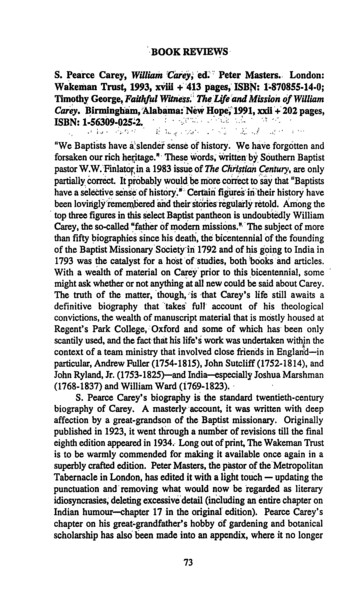
![Welcome [carey.jhu.edu]](/img/15/gmba-welcome-packet-class-2020.jpg)
